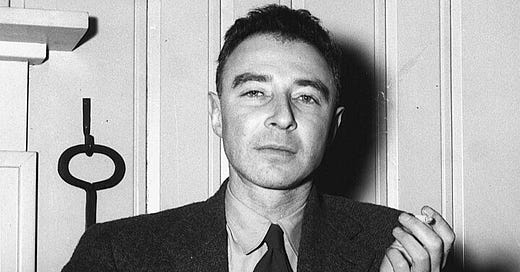Hey WeekInTime readers,
We’re bringing you a special edition this week about the one and only J. Robert Oppenheimer! We figured, why not join the Barbenheimer train? After you read our special edition below, you can check out our WeekInTime article about Barbie. At the very least, it’s definitely easier than trying to get IMAX tickets to see two movies on the same day.
Subscribe below full access to our full article!
It was early 1943 when J. Robert Oppenheimer invited a friend over for dinner. Haakon Chevalier was a fellow professor at the University of California Berkeley, and he and his wife were visiting Robert and Kitty Oppenheimer before the couple left for a top-secret mission in a desert in New Mexico.
When Oppenheimer (“Oppie”) slipped out of the room to make martinis in the kitchen, Haakon followed. He explained that a mutual acquaintance had asked him whether Oppenheimer would pass scientific information to the Soviet consulate in San Francisco. Outraged, Oppenheimer told Haakon that that was “treason,” and that he would take no part. The martinis were served, and that was the end of it—or so he thought.
“A man’s life can turn on a small event,” write Kai Bird and Martin J. Sherwin in American Prometheus, a biography of J. Robert Oppenheimer. “It was merely a brief conversation with a friend. But what was said, and how Oppie chose to deal with it, so shaped the remainder of his life that one is drawn to comparisons with the tragedies of classical Greece and Shakespeare.”
The Prodigy
Born in New York City in 1904, J. Robert Oppenheimer had a privileged upbringing. His mother was a painter and his father was a German-born textile importer who made a fortune. Just to really paint it for you, the family’s private art collection boasted three van Goghs.
It was apparent from a young age that Oppie would go on to do great things. He graduated from Harvard summa cum laude in just three years, after which he studied at the University of Cambridge in the U.K. and earned his doctorate at the University of Göttingen in Germany, one of the centers for theoretical physics. When he was just 25, he accepted a dual professorship at the University of California Berkeley and The California Institute of Technology.
Most of his early research dealt with the energy processes of subatomic particles, as well as questions related to neutron stars and black holes. Though his research was certainly groundbreaking, his teaching is really what set Oppenheimer apart from his peers.
He could be short-tempered with his students, but he always challenged them to think big. “Here was a man who obviously understood all the deep secrets of quantum mechanics, and yet made it clear that the most important questions were unanswered,” said Hans Bethe, a contemporary of Oppenheimer who went on to win the Nobel Prize. “He never gave his students the easy and superficial answers but trained them to appreciate and work on the deep problems.” According to Bethe, Oppenheimer created the “greatest school of theoretical physics that the United States has ever known.”
If you haven’t figured it out by now, Oppie had an insatiable hunger for knowledge. He was a polymath, who excelled in subjects ranging from physics and chemistry to Greek and Latin. He loved poetry, read philosophy, and learned several languages, including Sanskrit. His mind was a sponge, constantly absorbing and retaining the newest research in a variety of scientific fields. According to Richard Rhodes, the author of The Making of the Atomic Bomb, this quality is part of what made Oppenheimer the ideal choice for lab director at Los Alamos, the research site of the first atomic bomb. The bomb was an interdisciplinary project, pulling from physics, math, chemistry, metallurgy, engineering, etc. Oppenheimer was able “to keep the whole enterprise in his head,” helping scientists in every specialty when they got stuck.
Keep reading with a 7-day free trial
Subscribe to WeekInTime to keep reading this post and get 7 days of free access to the full post archives.




